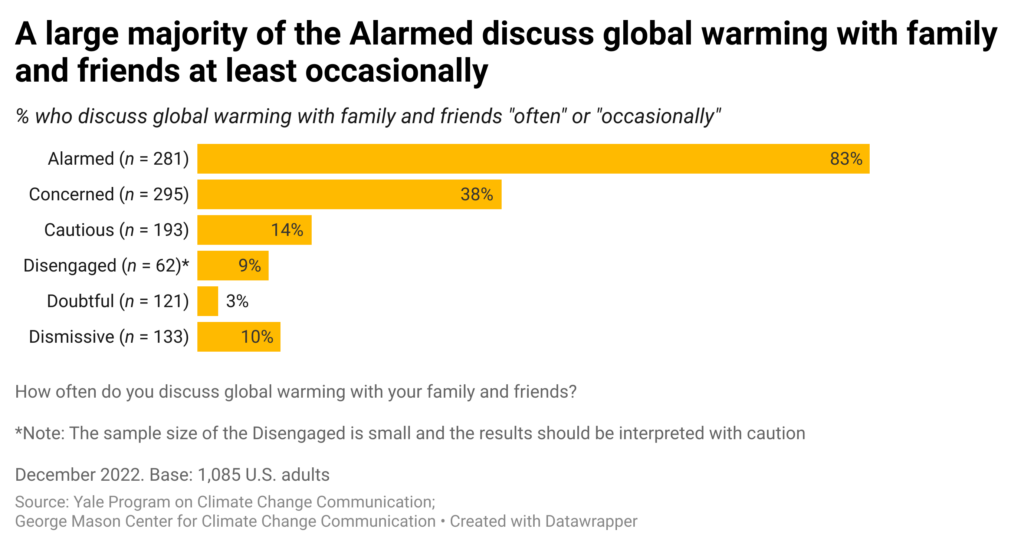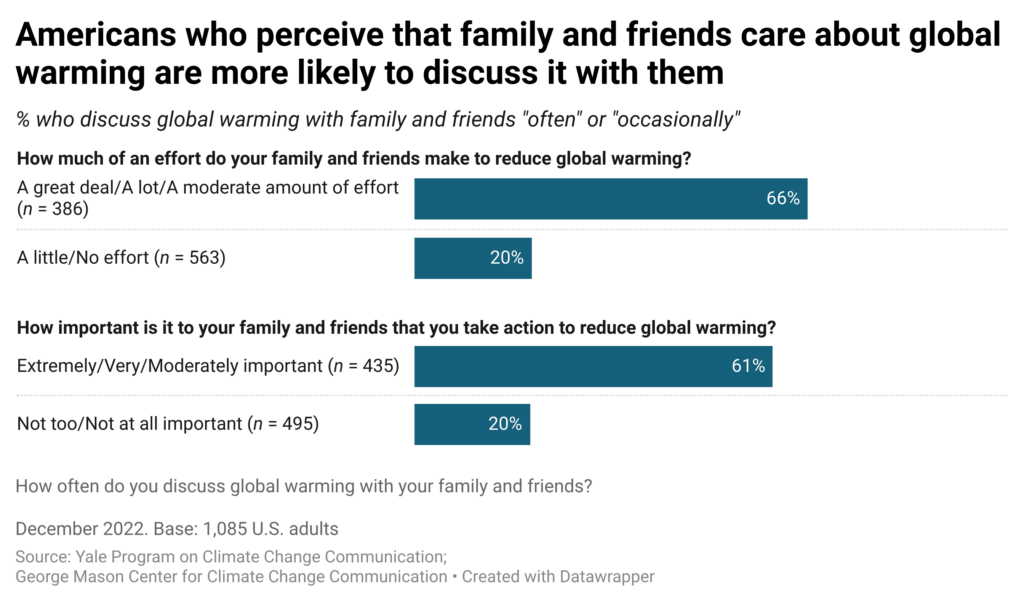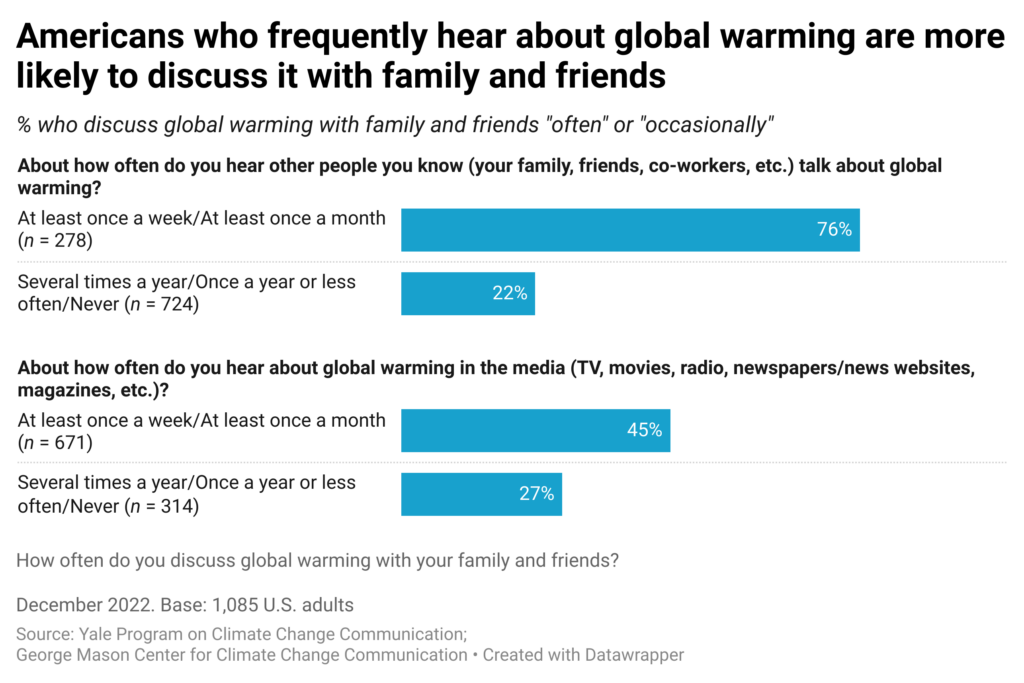Climate Note · May 18, 2023
Who is most likely to talk about climate change?
By Matthew Ballew, Matthew Goldberg, Marija Verner, Seth Rosenthal, Edward Maibach, John Kotcher and Anthony Leiserowitz
Filed under: Behaviors & Actions, Audiences and Beliefs & Attitudes

One of the most important actions people can take to address global warming is to talk about it, says Dr. Katharine Hayhoe, climate scientist and Chief Scientist at The Nature Conservancy. According to Dr. Hayhoe, positive conversations about the climate can help people connect over shared values including family, community, health, and religion. In turn, this can help people think more deeply about how a changing climate affects who and what they care about, and support changes in beliefs and attitudes about global warming.
Research has found that non-judgmental one-on-one discussions (e.g., deep-canvassing) can lead to enduring opinion changes about emotionally and politically charged topics by providing an opportunity to exchange personal stories without judgment. Talking about an issue – including global warming – can also lead to deeper processing and understanding, which can motivate people to talk about it with others.
However, most Americans rarely or never talk about global warming currently. According to our latest Climate Change in the American Mind December 2022 survey, only 37% of Americans say they discuss global warming with family and friends either “occasionally” (29%) or “often” (8%), while most (63%) say they either “rarely” (30%) or “never” (33%) discuss it.
In this analysis, we use our latest data to identify the types of people most likely to talk with family and friends about global warming and some characteristics that may help to explain why they do. Although the data presented here are correlational and cannot determine causal relationships, the results suggest ways to support more climate conversations by the public.
Results
Of all the demographic groups examined, Democrats, people with a Bachelor’s degree or higher, urban residents, Gen Z and Millennials, and Hispanic/Latino Americans are among the groups most likely to discuss global warming with family and friends (more than 40% in each group say they discuss it at least occasionally). The groups least likely to discuss global warming include Republicans, rural residents, people with a high school education or less, and people who do not identify with a party or are not interested in politics (less than 30% in each group say they discuss it with family and friends at least occasionally). Liberal Democrats (68%) are the most likely to discuss global warming, while conservative Republicans (11%) are the least likely to discuss it.
Additionally, we investigated how people’s overall climate views are related to the frequency of conversations about global warming. The Global Warming’s Six Americas framework identifies a spectrum of six distinct groups within the American public ranging from the Alarmed, who are the most likely to think global warming is happening and are the most worried about it, to the Dismissive, who are the most likely to think global warming is not happening and are the least worried about it. A large majority of the Alarmed (83%) discuss global warming with family and friends, while the Cautious (14%), Disengaged (9%), Doubtful (3%), and Dismissive (10%) are much less likely to. This indicates that people who are worried about global warming are much more likely to talk about it.
We also explored the relationship between perceptions of social norms and hearing others talk about the issue, and the frequency of discussing global warming. Social norms can have a powerful influence on people’s behavior. Descriptive norms refer to people’s perceptions of what others are doing (i.e., how much of an effort family and friends make to reduce global warming) and injunctive norms refer to people’s perceptions of what others expect them to do (i.e., how important it is to family and friends that you take action to reduce global warming). Americans who perceive stronger descriptive (66%) or injunctive norms (61%) regarding global warming are more likely to discuss global warming with family and friends than those who perceive weaker descriptive (20%) or injunctive norms (20%).
Additionally, Americans who hear other people (e.g., families, friends, co-workers) talk about global warming at least once a month or more often are more likely to discuss it with family and friends (76%) than are those who hear other people talk about global warming less often (22%). Similarly, Americans who hear about global warming in the media at least once a month or more often are more likely to discuss it (45%) than those who hear about it in the media less often (27%). Consistent with previous research, these findings suggest that encouraging more people to talk about global warming and more climate journalism can help create a positive self-reinforcing feedback loop that supports more pro-climate social norms and increased rates of climate conversation.
Taken together, these results show that certain groups in the U.S. (e.g., Democrats, people with higher education, urban residents, Gen Z and Millennials, and Hispanic/Latino Americans) are more likely than other groups to talk about global warming. Americans who are Alarmed about global warming are also much more likely to discuss the issue than are those who are less worried and engaged. Additionally, supportive social contexts play an important role. Americans who say their family and friends care about global warming are more likely to discuss it with them, and people who frequently hear others (e.g., family, friends, the media) talk about global warming are more likely to talk about it themselves.
These findings align with experimental research showing that perceiving social norms supportive of climate change can lead to a greater willingness to discuss it, and longitudinal research showing that talking about climate change can strengthen pro-climate views and motivate further climate discussions. Together, these studies indicate that there is a relationship between pro-climate beliefs, perceptions of others’ beliefs, and talking about climate change that can help break the “spiral of silence” on the issue. Indeed, social influence strategies are among the most effective ways to promote climate change mitigation behaviors.
This represents an opportunity for educators and communicators to support the public with strategies to engage in more climate conversations. According to Dr. Hayhoe in her new book, Saving Us, “We want to talk about it; we just don’t know how…We have to go out and actively look for the hope that we need that will inspire us to act – and that hope begins with a conversation today.”
Want to know more? This Yale Climate Connections article offers additional insights into how to have meaningful conversations about climate change, and Dr. Hayhoe’s TED Talk models how to talk about climate change by discussing shared values. Other resources about how to have climate conversations include:
- Our Climate Our Future: The Secret to Talking About Climate Change
- YPCCC: Attaining Meaningful Outcomes from Conversations on Climate
- The Nature Conservancy: Let’s Talk Climate
- Talk Climate Change
- Breaking The Climate Spiral of Silence: Lessons from a COP26 Climate Conversations Campaign
- UNICEF: Talking to Your Child About Climate Change
- NRDC: Your Guide to Talking With Kids of All Ages About Climate Change
Methods
The results of this report are based on the December 2022 data (n = 1,085) of the bi-annual Climate Change in the American Mind survey – a nationally representative survey of U.S. public opinion on climate change conducted by the Yale Program on Climate Change Communication and the George Mason University Center for Climate Change Communication. Data were collected from December 2 – 12, 2022 using the Ipsos KnowledgePanel®, a representative online panel of U.S. adults ages 18 and older. Respondents self-administered the questionnaires online in a web-based environment. The audience segmentation analysis used the Six Americas Super Short Survey (SASSY) tool.
Data for each survey wave were weighted to align with demographic parameters in the United States. Following Pew Research Center’s approach, generational cohort and year of birth were calculated based on the age of respondents at the time of data collection (Gen Z: 1997-2012; Millennial: 1981-1996; Gen X: 1965-1980; Baby Boomer: 1946-1964; and Silent Generation: 1928-1945). Because generational cohort classification was based on respondents’ age at the time they took the survey (rather than birth year, which was not known), some respondents on the cusp of two generations may be miscategorized. We are unable to describe the views of other racial/ethnic groups (including Asian Americans, Native Americans, and adults who identify with 2+ races) because of sample size limitations.
References to Republicans and Democrats include respondents who initially identify as either a Republican or Democrat, as well as those who do not initially identify as a Republican or Democrat but who say they “are closer to” one of those parties (i.e., “leaners”) in a follow-up question. The category “Independents” does not include any of these “leaners.”
In figures/data tables, bases specified are unweighted, while percentages are weighted to match national population parameters. For tabulation purposes, percentage points are rounded to the nearest whole number. The average margin of error is +/- 3 percentage points at the 95% confidence interval for the full sample of U.S. adults (n = 1,085). The data tables used to develop the charts/figures include the margins of error at the 95% confidence interval for each subgroup.



